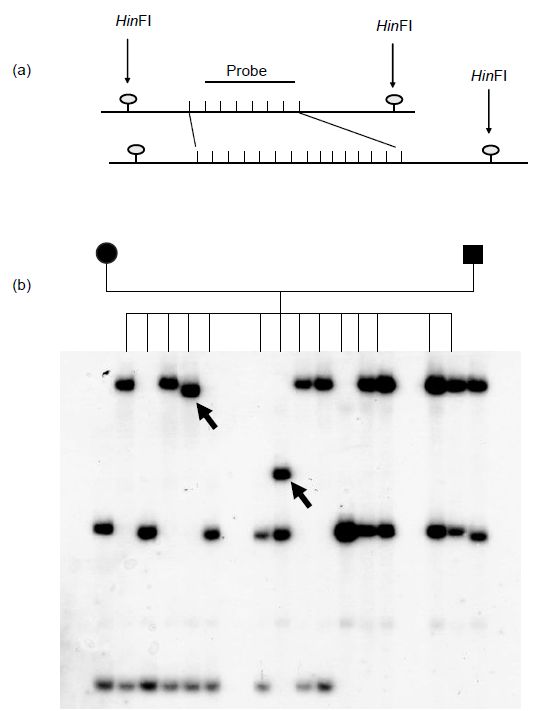
RFLPs and Minisatellites
 المؤلف:
John M Walker and Ralph Rapley
المؤلف:
John M Walker and Ralph Rapley
 المصدر:
Molecular Biology and Biotechnology 5th Edition
المصدر:
Molecular Biology and Biotechnology 5th Edition
 الجزء والصفحة:
الجزء والصفحة:
 21-11-2020
21-11-2020
 2883
2883
RFLPs and Minisatellites
The first DNA polymorphisms were detected using Southern blotting techniques of genomic DNA digested with restriction enzymes. This gave rise to restriction fragment length polymorphisms (RFLPs), which are due to the cleavage of certain alleles and the lack of cleavage of alternative alleles, resulting from the presence or absence of specific restriction enzyme recognition sites in the DNA. Southern blotting involves the transfer of DNA fragments generated by restriction enzyme digestion from an electrophoresis gel to an immobilising membrane such as nitrocellulose or nylon. The immobilised DNA is then probed with a radioactively or biotin-labelled DNA probe that could have originated from a cDNA clone or a genomic DNA clone or a PCR product. When the autoradiograph of the probed DNA digests from a set of unrelated individuals was examined, person to person variation in the resulting pattern of the bands identified an RFLP. The majority of RFLPs consist of two alleles (cut and uncut) and are found to result from single nucleotide replacements (Figure 1). Southern blotting remains one of the simplest methods to analyse gene dosage. The amount of the labelled probe that hybridises to the filter bound ‘target’ is proportional to the amount of target on the filter. Hence, when comparing the band patterns of samples that have been very carefully loaded on to the electrophoresis gel, it is possible to make a quantitative assessment using densitometry to measure the intensity of the bands on the X-ray film.
Restriction enzyme analysis of human DNA gave rise to a further class RFLPs known as VNTRs, where the variation is in the length of the DNA rather than the presence or absence of restriction enzyme sites. VNTRs are blocks of repetitive DNA sequences called minisatellites that occur throughout the genome, but that tend to be found towards the ends of human chromosomes. Hypervariable minisatellites were discovered by Jeffreys et al. in 1985 and were detected by hybridisation of a minisatellites probe to Southern blots of DNA digested with a restriction enzyme, usually HinF1, that cuts the DNA either side of the minisatellites. DNA probes such as 33.15 recognise a common core sequence of about 10–15 base pairs which was shared between many different minisatellite loci. These multilocus probes revealed tremendous person-to-person variations in the complex patterns of bands which became known as DNA fingerprints.36 DNA fingerprints were of great utility to forensic medicine and other fields where it was necessary to identify individuals unambiguously; however, DNA fingerprints were not amenable to mendelian segregation analysis or gene mapping because it was not possible to assign alleles within the complexity of bands displayed on the X-ray film.
A considerable advance with respect to gene mapping was made following the discovery of single-locus VNTR probes. Single-locus probes (SLP) were developed from specific cloned minisatellites and are thus able to detect individual minisatellite loci. They produce simple patterns on Southern blots in which heterozygous individuals display two bands and homozygotes a single band. Hence SLPs were useful for gene mapping since the bands could be tracked through families (Figure 2).


Figure 1. RFLP analysis of a 600 bp PCR product. (a) Schematic analysis of products from heterozygous and homozygous individuals digested with a restriction endonuclease. Three bands arise from the heterozygous individual, one which represents an uncleaved fragment and the other a cleaved fragment. (b) An SfaII RFLP revealed in six individuals following digestion of a 600 bp PCR product.

Figure 2. (a) Schematic illustration of a heterozygous VNTR locus. The invariant HinfI sites reveal a length polymorphism resulting from the repeat number variation in the two minisatellite alleles. (b) Southern blot analysis of hypervariable minisatellite B6.7 using a single locus probe on HinfI digests of genomic DNA from a large family. The arrows indicate new mutations not found in either parent.
The average heterozygosity of polymorphic VNTR loci is about 70%; those loci with very high heterozygosities, such as B6.7 in Figure 2, tend to exhibit considerable mutability and instability. It is estimated that there are between 15 000 and 20 000 VNTR loci in the human genome. However, as they tend to cluster preferentially near the ends of chromosomes, they are of limited use for genome mapping purposes.
Interestingly, it has since been discovered that the repeat blocks in many VNTR loci vary slightly within the sequences of the repeats, giving rise to repeat types along the length of the two alleles. These variants are detectable by PCR-based methods and they are the basis of the minisatellite variant repeats (MVR) system. This is a highly informative and elegant means of producing individual genetic barcodes which could be of tremendous use in forensic analysis of individuals in humans and many other species.
 الاكثر قراءة في مواضيع عامة في الاحياء الجزيئي
الاكثر قراءة في مواضيع عامة في الاحياء الجزيئي
 اخر الاخبار
اخر الاخبار
اخبار العتبة العباسية المقدسة


